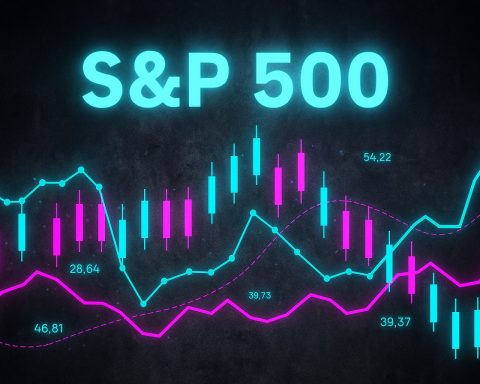- Biggest Stock Drop in Weeks: U.S. markets just saw their steepest one-day slide in nearly a month amid fears that high-flying tech stocks are overvalued. The Nasdaq Composite tumbled over 2% on Tuesday, the S&P 500 lost about 1.2%, and even the Dow Jones (with fewer tech names) shed roughly 0.5% [1] [2]. Tech shares were the hardest hit, dragging major indexes sharply into the red.
- Tech AI Bubble Jitters: Investors are growing anxious that an “AI bubble” may have formed after this year’s explosive rally in tech. Valuations of AI-linked companies — from U.S. giants like Nvidia and Palantir to Asian firms like Samsung — have surged to record highs [3]. Now traders are questioning the wisdom of chasing these sky-high prices, prompting a wave of profit-taking in technology stocks [4].
- Wall Street Correction Warnings: Top Wall Street CEOs are openly cautioning that a market correction is likely. Goldman Sachs chief David Solomon said a 10–20% drawdown in equity markets is “likely” in the next 12–24 months [5], and Morgan Stanley’s Ted Pick suggested investors should “welcome” the possibility of a 10–15% pullback as a healthy reset [6]. (JPMorgan’s Jamie Dimon similarly warned last month that the chance of a significant stock drop in the next six months to two years is elevated [7].) These warnings have rattled investors and contributed to this week’s sell-off.
- Global Sell-Off Ripple: The market jitters aren’t confined to the U.S. — they’re global. Asian markets plunged in sympathy on Wednesday after Wall Street’s drop. Japan’s Nikkei index nosedived nearly 5% at one point, and South Korea’s tech-heavy Kospi briefly sank about 6% before paring losses [8] [9]. Major chipmakers like Samsung Electronics and SK Hynix – darlings of the AI boom – saw their shares plunge around 7% in a single session [10]. From Hong Kong and Shanghai to Sydney and Singapore, it was a “sea of red” across trading screens [11].
- Crypto Slump Too: Even Bitcoin wasn’t spared. The leading cryptocurrency briefly dropped below the symbolic $100,000 level for the first time since June amid the broader risk-off mood [12]. (Bitcoin had hit a record high above $126,000 just a month ago, so this retreat is notable [13].) The pullback in crypto is seen as part of investors pulling back from speculative assets in general.
- Broader Uncertainties Loom: This volatility comes against a backdrop of other headwinds. The Federal Reserve’s next moves are uncertain – traders had banked on rate cuts continuing into 2026, but Fed officials recently warned that another cut in December is “not a foregone conclusion,” jolting market sentiment [14]. Additionally, the U.S. government shutdown (now stretching into a record 36th day) is undermining investor confidence and depriving markets of official economic data [15] [16], adding another layer of uncertainty for traders to navigate.
- Not All Doom and Gloom: Despite the flurry of warnings, many experts still see this as a necessary cooling-off rather than the start of a crash. Corporate earnings have been strong, and expected policy support (like eventual interest rate cuts) could keep the economy afloat [17]. “None of us are market timers… stay invested,” advised Goldman’s Solomon, stressing that sticking to a long-term strategy has “served people well” so far [18]. Some analysts argue that today’s tech giants are on firmer financial footing than the dot-com era, so pullbacks could be healthy pauses to let fundamentals catch up [19] [20]. In other words, a correction now might reset frothy valuations without derailing the broader bull market.
Rally Meets Reality: Tech Stocks Finally Cool Off
After a year of spectacular gains, stocks have abruptly stumbled, raising the question of whether the market got ahead of itself. The S&P 500 and Nasdaq Composite just suffered their biggest one-day percentage drops since early October [21], a sign that the gravity-defying surge in tech shares is meeting some pushback. On Tuesday (Nov. 4), the Nasdaq sank over 2% while the S&P 500 fell around 1.2%, and the Dow – which is less tech-centric – dipped 0.5% [22].
What triggered the abrupt shift in sentiment? Valuations. Investors are increasingly nervous that the price tags on many technology and AI-focused companies have become unsustainably high. “Investors seem a little more worried about valuation than they have in a while,” observed analyst Chuck Carlson, noting that a lot of companies’ stock prices were “pretty stretched” relative to their earnings, which were good “but not great” – a classic recipe for profit-taking [23]. In other words, even solid earnings may not be enough to justify stocks that have run up so far, so fast.
Much of 2025’s market rally has been driven by a very narrow group of superstar tech stocks. Traders poured cash into the “Magnificent Seven” – a handful of AI-related mega-cap companies – propelling the Nasdaq and S&P 500 to record highs despite mixed economic signals [24] [25]. This narrow leadership led to poor breadth in the market, meaning gains were concentrated in a few names while many other stocks lagged [26]. Such imbalances can make the market more fragile. Indeed, by early November some technical indicators were flashing overbought conditions, and optimism had become “intense” with many traders focused on chasing gains rather than questioning lofty prices [27].
On Tuesday, that optimism finally cracked. Six of the seven biggest tech players fell on the day [28]. High-flyers like Palantir – which had surged over 150% year-to-date – plunged 8% in one session despite reporting stellar earnings and raising its outlook [29]. “A lot of these companies’ valuations were pretty stretched… And that’s a recipe for profit-taking,” Carlson explained, as investors seized the chance to lock in gains [30]. The sell-off was broad: the Philadelphia Semiconductor Index, which tracks chip stocks crucial to the AI boom, dived 4% [31], wiping out an estimated $500 billion in combined market value from global semiconductor shares in just 24 hours [32]. The mood abruptly shifted from euphoria to caution, as evidenced by a rush into safe havens – bond prices rose (yields fell) and gold spiked about 1% on the day [33] [34].
AI Bubble Fears and Frothy Valuations
Underpinning the market’s swoon is a growing concern that the spectacular boom in artificial intelligence stocks may have morphed into a bubble. Global markets have soared in 2025 on an “eye-watering flood of cash” into anything related to AI – from U.S. titans like Nvidia, Amazon, and Apple to Asian tech firms such as Samsung and Alibaba [35]. The frenzy has been fed by genuine optimism about AI’s profit potential and by supportive macro conditions (easing trade tensions and hopes that the Federal Reserve will cut interest rates further) [36]. This dynamic sent the U.S. benchmark S&P 500 up nearly 40% from its lows in April to recent highs [37] – a record-breaking rally that pushed stock prices to levels “typically associated with exuberance” [38].
But as prices kept climbing, so did voices of caution. By the fall, even some veteran market bulls started warning that parts of the market were looking bubbly. In September, Fed Chair Jerome Powell gently noted that equity valuations were “fairly highly valued” by historical standards [39]. A recent International Monetary Fund report pointed out that asset prices appeared “well above fundamentals,” which raises the risk of “disorderly corrections” if any shock hits [40]. In plainer terms, stocks seemed priced for perfection, leaving little margin for error.
The AI theme in particular has drawn comparisons to the late-1990s dot-com bubble. The surge of investment into AI chips, software, and cloud computing has been compared to the dot-com era’s optimism – though importantly, today’s tech leaders are far more profitable and established than the startups of 2000. “Warnings about frothy stock valuations are easy to find after a record-breaking rally,” noted a Bloomberg markets wrap, describing how traders’ optimism had turned “intense” in recent months [41]. Many were chasing momentum, assuming AI will transform the economy overnight, and neglecting the possibility that even transformative technologies can get over-hyped in the short run.
Those fears crystalized this week around some high-profile warnings (more on that next). But even before the big bank CEOs spoke up, market action hinted at jitters. As one strategist observed, traders had already started quietly rotating – pulling money out of riskier, “lower-quality” stocks and concentrating into perceived “higher-quality” plays – resulting in notably narrow market breadth [42]. “It’s a sea of red across broad markets, and one that offers a gloomy and damp portrayal of risk,” wrote analyst Chris Weston as tech stocks worldwide sank, noting that the long rally had finally run into a wall of valuation anxiety [43]. Once the selling started, it fed on itself: traders began “cutting back on their winners and locking in performance,” especially in the big tech names that had delivered outsized gains [44]. In short, the market needed to take a breather – and now it’s doing just that.
Wall Street Titans Sound the Alarm on Overheated Markets
Perhaps the biggest catalyst for this week’s sell-off was the blunt message delivered by some of Wall Street’s most influential figures: Brace yourselves – a pullback is coming. On Tuesday, at a financial forum in Hong Kong, the CEOs of Goldman Sachs and Morgan Stanley openly warned that the stock market’s extraordinary run-up is due for a reversal [45].
Goldman Sachs CEO David Solomon cautioned that a 10% to 20% drop in equity markets is “likely” over the next year or two [46]. Morgan Stanley chief Ted Pick agreed, suggesting investors should “welcome the possibility” of a 10%+ correction – so long as it’s not triggered by some shock event – as a necessary breather for markets [47]. “Things run and then they pull back,” Pick noted, implying that this is a normal part of market cycles. Both men stopped short of predicting an imminent crash, but their tone was a notable shift: after a year of relentless bullishness, top bankers are effectively telling investors that risk is rising.
These comments, delivered at the Global Financial Leaders Investment Summit, reverberated instantly through markets. U.S. stocks swooned Tuesday as headlines hit that even the Titans of Finance think stocks are too pricey. “Investors didn’t like the sound of that,” one outlet dryly noted, as the Nasdaq quickly fell nearly 2% following the remarks [48]. It’s unusual for sitting bank CEOs to predict market drops, so their frankness grabbed attention. (Solomon had actually hinted at similar concerns a month earlier at a conference in Italy, but reiterating them now – with stocks at new highs – carried extra weight [49].)
They weren’t alone. In recent weeks, Jamie Dimon of JPMorgan also warned that the odds of a major correction (he mentioned the next 6–24 months) are higher than people realize [50], citing geopolitical tensions among other risks. These warnings tap into a broader anxiety: after such a long stretch of markets mostly going up, investors may be complacent about the possibility of a downturn. Even Federal Reserve officials have gently signaled concern – for instance, Fed Governor Christopher Waller mused that if an asset bubble is forming due to AI, “we’ll pop it” with policy if needed [51]. In other words, authorities are aware of the exuberance.
So, what should investors do? Interestingly, despite their caution about valuations, Solomon and Pick are not advising anyone to run for the exits. Solomon emphasized that neither he nor his peers are in the business of calling short-term market tops: “None of us are market timers,” he said, adding that Goldman’s advice to clients is to stay invested with a balanced portfolio [52]. That steady approach, he noted, “has served people well” over time [53]. In Solomon’s view, while parts of the market (tech) are in the 80th percentile of historical valuations, plenty of other stocks look reasonably valued given their earnings growth [54]. Fiscal policy is supportive, and there are “lots of things where the multiples aren’t as full,” he said, suggesting that opportunities remain [55]. In short, the message is to be vigilant but not panic. As CNBC’s market commentator Jim Cramer quipped amid the debate: “Are valuations too high? They are always too high” [56] – a tongue-in-cheek reminder that calling a top is notoriously difficult.
Global Aftershocks: Asia’s Tech High-Fliers Crater
Once Wall Street sneezes, the saying goes, the rest of the world catches a cold. That played out this week as global markets echoed the U.S. downturn. By Wednesday morning (Nov. 5) in Asia, a wave of selling hit major exchanges from Tokyo to Seoul to Hong Kong [57]. Many of these markets had themselves been at record or multi-year highs just days earlier, riding the same AI-driven euphoria. Now they faced a harsh reversal.
Japan’s Nikkei 225 index – which has been one of the year’s top performers – plunged as much as 4.7% [58]. In Tokyo, shares of tech conglomerate SoftBank Group, a big investor in AI startups, collapsed 14% in one day [59]. Even Sony fell over 2% [60]. South Korea’s Kospi index, another major winner of 2025 thanks to its chip companies, nosedived 6% at one point [61]. Market heavyweights Samsung Electronics and SK Hynix each saw their stock tumble around 7% amid the rout [62]. The sell-off was so sharp that Korean regulators briefly halted program trading (via a “sidecar” mechanism) when futures plunged past a limit, an automatic brake not triggered since April.
“I view today’s decline as a correction to cool off an overheated market – a phase of adjustment,” explained Chung Hae-chang, an analyst at Daishin Securities in Seoul, as he watched the Kospi skid [63]. “The recent rally was extremely steep, so this is the counterbalance,” he added, noting that such a pullback, while jarring, could ultimately be healthy [64]. Still, Chung cautioned that Seoul’s market might have another 5% to fall before valuations normalize, and that even blue-chip names like Samsung may see further declines “proportional to their earlier gains” [65].
Other Asia-Pacific markets were awash in red ink as well. Benchmarks in Hong Kong, Shanghai, Singapore, Sydney, and Mumbai all fell on Wednesday [66]. The MSCI Asia-Pacific index (ex-Japan) dropped about 1.1% overall [67]. There were a few bright spots: Chinese stocks managed to stabilize and even rise later in the day, helped by Beijing’s announcement of tariff relief in the trade war (seen as a positive for growth) [68]. And in Tokyo, one stock – Nintendo – defied the gloom, jumping over 10% after the gaming company raised profit forecasts on strong Switch 2 console demand [69]. But those were exceptions in what one analyst called “a sea of red across broad markets” [70].
The global rout in tech also hammered the semiconductor sector, which is the backbone of the AI boom. From Silicon Valley to Seoul and Taipei, chip stocks fell sharply. The Philadelphia Semiconductor Index’s slump on Tuesday erased roughly $500 billion in market capitalization [71], and the pain continued into Wednesday for Asian chipmakers [72]. Investors have been particularly sensitive to chips because they were seen as canaries in the coal mine – if AI demand even slightly disappoints or if orders slow, chip earnings could suffer, and their lofty stock prices leave no room for error.
Crypto and Other Speculative Assets Feel the Pain
The flight from risky assets didn’t stop at the stock market. In the crypto world, traders also hit the sell button. Most notably, Bitcoin – which had been on a tear for much of 2025 – dipped below $100,000 for the first time in several months [73]. Just in October, Bitcoin hit an all-time high above $126,000 [74], fueled by enthusiasm for blockchain and alternative assets amid loose monetary conditions. But as interest rates crept up and regulators hinted at tighter oversight, crypto’s momentum started to wane. The broad risk-off sentiment this week accelerated that reversal, knocking Bitcoin down into five-digit territory again.
Analysts say it’s not surprising to see crypto retrace some gains when high-flying tech stocks are also stumbling. “A firmer dollar, weaker crypto markets, and valuation concerns in U.S. Big Tech have all combined to pressure risk sentiment,” observed Charu Chanana, chief investment strategist at Saxo Markets [75]. In other words, many of the same factors spooking stock investors – rising yields earlier in the year, talk of an AI bubble, and now a rush to safety – are also hitting Bitcoin and its peers. Other cryptocurrencies and crypto-related stocks fell in tandem with Bitcoin. Crypto mining companies saw their shares slide, and the overall crypto market cap slipped about 2.5% over 24 hours [76].
Despite the pullback, crypto insiders note that Bitcoin is still up dramatically for the year (it was trading near $50K at the start of 2025). Some volatility is to be expected given how fast it ran up. The question is whether this dip below $100K is temporary or the start of a deeper correction in crypto prices. As with stocks, opinions vary – true believers remain bullish long-term, while skeptics argue that crypto valuations, like tech stocks, may have outpaced reality in the short run. For now, Bitcoin’s slide is another symptom of investors becoming more conservative and selective after a period of exuberance.
Outlook: Healthy Correction or Start of Something Worse?
With markets suddenly on edge, everyone is asking: Is this just a healthy correction, or a warning of worse to come? The consensus among many analysts and insiders is that a moderate pullback was overdue – and even welcome – given how far and fast stocks had climbed. “A pullback was overdue after strong and steady gains in tech,” said Saxo’s Charu Chanana [77], who sees the recent dip as a natural cooling-off. Indeed, periodic corrections (typically defined as a drop of 10% or more from recent highs) are common even in long bull markets. They serve to “reset” valuations and prevent excessive “irrational exuberance,” to borrow former Fed Chair Alan Greenspan’s famous phrase [78]. During the 1990s tech boom, Greenspan warned of overvaluation years before the bubble actually burst – a reminder that bubbles can inflate for a long time before they finally pop [79].
Several factors suggest that this correction, while perhaps painful in the short term, might stay orderly. First, the economic backdrop, though mixed, is not outright recessionary. In fact, many Big Tech companies are delivering solid earnings growth (one reason their stocks ran up) [80]. “Earnings are strong; what’s challenging are valuations,” as Capital Group CEO Mike Gitlin put it [81]. If corporate profits continue to rise, they could “grow into” some of the high valuations over time, especially outside the most hyped AI names.
Second, interest rates – a huge factor for stock valuations – may soon become more friend than foe. The Federal Reserve aggressively raised rates in 2022–2023, which initially put a lid on speculative excess. But now inflation is cooling and many expect the Fed to start cutting rates in 2024, which would lower borrowing costs and support stock prices [82]. While Fed officials have been noncommittal (and, as noted, even pushed back on assuming a December cut [83]), the overall trajectory of policy appears to be easing into 2025 and 2026 [84]. Historically, a shift from tightening to easing has often extended bull markets – unless a severe shock intervenes.
Third, the market’s foundations may be stronger than surface appearances suggest. Unlike the dot-com era, today’s tech giants are massively profitable, cash-rich, and core to the economy. Some analysts argue that the AI leaders – companies building real products and services around artificial intelligence – are not just hype machines, but have tangible earnings and cash flows to back up a portion of their valuations [85]. This doesn’t mean their stocks can’t fall (they clearly have this week), but it implies that if they do fall further, bargain hunters may step in. “I don’t think we’re at the late stage of the AI bubble; there’s still room to go, so there’ll be some bottom fishers,” commented Xin-Yao Ng, a fund manager at Aberdeen Investments, expressing confidence that dips will attract buyers [86].
That said, risks remain. Market pullbacks can gain momentum in unpredictable ways. One oft-cited concern is that so many investors have piled into the same crowded trades (Big Tech, AI, etc.) that when momentum reverses, the unwinding can be swift. Geopolitical flare-ups or a sudden economic shock (for example, a credit event or a sharp resurgence of inflation) could turn a healthy correction into something more unnerving. It’s also worth noting that market psychology is fickle – after months of extreme greed, sentiment can swing toward fear, which sometimes overshoots to the downside. Volatility indices have spiked, and if earnings guidance from companies or macro data turn negative, the current correction could deepen.
Policymakers will be closely watching the situation. The fact that a U.S. government shutdown is dragging on (now the longest in history) doesn’t help confidence [87]. However, there is also a sense that this market drop is sending a message that could actually keep excesses in check. As one international strategist noted, the recent CEO warnings and modest downturn might be “a healthy development” because they remind investors that stocks can go down [88]. After a year of seemingly endless gains, a bit of humility in markets could avert a bigger crash later.
For everyday investors, the overarching advice from experts is to stay level-headed. “Look at your portfolio allocation and stay invested,” Solomon advises, rather than trying to time every twist and turn [89]. Diversification – including some exposure to value stocks or defensive sectors – can cushion the ride when the high-fliers falter (indeed, on Tuesday, sectors like financials and consumer staples held up relatively well [90]). Holding some cash or bonds as dry powder isn’t a bad idea either, as bonds have been rallying in this risk-off wave [91]. That way, if stocks do fall another 10% from here, disciplined investors could rebalance or selectively buy the dip in quality companies.
In summary, the stock market’s hot streak has hit a speed bump. A combination of stretched valuations, AI bubble fears, and high-profile warnings has injected a dose of volatility and caution. A 10–20% correction – the kind Solomon and Pick anticipate – would certainly test investors’ nerves, but many analysts see it as a healthy pause that could ultimately extend the bull market by curbing excess. As the saying goes, markets take the stairs up and the elevator down. We’re on the elevator now, but it doesn’t mean we’re plunging into the basement. The next few weeks will reveal if this is a brief scare or the start of a broader trend. For now, it’s a wake-up call that even in the age of AI optimism, fundamentals and prudence still matter in investing.
Sources: Recent market news and analysis from Yahoo Finance [92] [93], Bloomberg [94] [95], CNBC/Reuters [96] [97], Investopedia [98] [99], and other financial outlets. Experts and executives quoted include David Solomon (Goldman Sachs) [100], Ted Pick (Morgan Stanley) [101], Jamie Dimon (JPMorgan) [102], Charu Chanana (Saxo Markets) [103], Chris Weston (Pepperstone) [104], Chung Hae-chang (Daishin Securities) [105], Mike Gitlin (Capital Group) [106], and others.
References
1. www.channelnewsasia.com, 2. www.channelnewsasia.com, 3. gulfnews.com, 4. www.channelnewsasia.com, 5. www.investopedia.com, 6. www.investopedia.com, 7. www.channelnewsasia.com, 8. gulfnews.com, 9. gulfnews.com, 10. gulfnews.com, 11. gulfnews.com, 12. gulfnews.com, 13. gulfnews.com, 14. gulfnews.com, 15. www.channelnewsasia.com, 16. www.swissinfo.ch, 17. www.swissinfo.ch, 18. www.investopedia.com, 19. www.investopedia.com, 20. www.investopedia.com, 21. www.channelnewsasia.com, 22. www.channelnewsasia.com, 23. www.channelnewsasia.com, 24. www.channelnewsasia.com, 25. gulfnews.com, 26. gulfnews.com, 27. www.swissinfo.ch, 28. www.channelnewsasia.com, 29. www.channelnewsasia.com, 30. www.channelnewsasia.com, 31. www.channelnewsasia.com, 32. www.swissinfo.ch, 33. www.swissinfo.ch, 34. www.swissinfo.ch, 35. gulfnews.com, 36. gulfnews.com, 37. www.swissinfo.ch, 38. www.swissinfo.ch, 39. www.investopedia.com, 40. www.investopedia.com, 41. www.swissinfo.ch, 42. gulfnews.com, 43. gulfnews.com, 44. gulfnews.com, 45. gulfnews.com, 46. www.investopedia.com, 47. www.investopedia.com, 48. www.investopedia.com, 49. www.investopedia.com, 50. www.channelnewsasia.com, 51. www.investopedia.com, 52. www.investopedia.com, 53. www.investopedia.com, 54. www.investopedia.com, 55. www.investopedia.com, 56. www.investopedia.com, 57. gulfnews.com, 58. gulfnews.com, 59. gulfnews.com, 60. gulfnews.com, 61. gulfnews.com, 62. gulfnews.com, 63. gulfnews.com, 64. gulfnews.com, 65. gulfnews.com, 66. gulfnews.com, 67. www.swissinfo.ch, 68. www.swissinfo.ch, 69. gulfnews.com, 70. gulfnews.com, 71. www.swissinfo.ch, 72. www.swissinfo.ch, 73. gulfnews.com, 74. gulfnews.com, 75. www.swissinfo.ch, 76. finance.yahoo.com, 77. www.swissinfo.ch, 78. www.investopedia.com, 79. www.investopedia.com, 80. gulfnews.com, 81. gulfnews.com, 82. www.investopedia.com, 83. gulfnews.com, 84. www.swissinfo.ch, 85. www.investopedia.com, 86. www.swissinfo.ch, 87. www.swissinfo.ch, 88. www.bloomberg.com, 89. www.investopedia.com, 90. www.channelnewsasia.com, 91. www.swissinfo.ch, 92. gulfnews.com, 93. gulfnews.com, 94. www.swissinfo.ch, 95. www.swissinfo.ch, 96. www.channelnewsasia.com, 97. www.channelnewsasia.com, 98. www.investopedia.com, 99. www.investopedia.com, 100. www.investopedia.com, 101. www.investopedia.com, 102. www.channelnewsasia.com, 103. www.swissinfo.ch, 104. gulfnews.com, 105. gulfnews.com, 106. gulfnews.com












